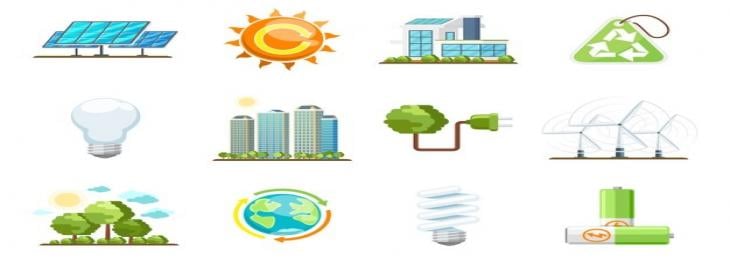
The world has gone through many changes since the time of its conception. The main factor that has enabled such a big planet to carry on with the activities and sustain life is energy. But as the population explosion has continued at a very progressive rate, exploitation of these energy sources is also continuing and likely to push the planet towards its end.
For long scientists have been busy finding various kinds of energy sources to save the earth, but these energy sources either have not been effective or cannot be afforded at a global rate. The main concern is how to maintain a balance between these sources, their use, and their effects.
From the invention of fire to glasses with the 3D spectrum, everything is based on energy. Even though there are various ways of categorizing the sources, the two main categories are-
- Non-renewable energies
- Renewable energies
What are non-renewable energies?
Non-renewable sources of energy are those that cannot be replenished once they have combusted. They may take millions of years to form and sometimes can go permanently extinct. These energy sources are also called fossil fuels. These were formed when the earth was going through rapid evolution and the decaying fossils of creatures that were alive at that time metamorphosed as fossil fuels under the influence of extreme heat band pressure. The main ingredient in these is carbon.
In the present-day world, fossil fuels build up to be the most important source of energy and electricity and are used extravagantly for daily needs. Now, a population of 7.7 billion people using these is a mode of major concern.
Sources of Non-renewable energies-
The major sources for fossil fuels are as followed-
- Coal-
Coal is a sedimentary rock formation in layers or strata called coal seams. It is highly combustible. The main elements present in coal are-
- Carbon (Majorly)
- Hydrogen
- Sulfur
- Oxygen
- Nitrogen
-
Petroleum-
The naturally formed greasy black liquid found in the earth’s interior is termed petroleum. It is a highly combustible fuel. Most of the global markets are based on petroleum as the main source of fuel. The stock market of petroleum is always dynamic and can lead to an increase and decrease in price rates. Raw petroleum is processed under a technique known as fractional distillation. This technique helps the separation of the liquid mixture in fractions based on different boiling points. The main elements in natural petroleum are naturally formed hydrocarbons.
When large quantities of dead microbes like zooplankton and algae are decomposed beneath sedimentary rock layers’ petroleum is formed. The vastly used way to collect petroleum is by drilling. The Kingdom of Saudi Arabia still holds the title as the largest dealer of petroleum in the global market.
-
Natural Gas-
Also known as fossil gas, natural gas is a naturally occurring gas with hydrocarbon as the main element. It also consists of methane and some other alkanes too. When decaying plants and animals are exposed to immense pressure and heat beneath the earth’s surface, the decomposition process leads to the build-up of natural gases. This process takes millions of years. The energies of the sun get stored in chemical bonds when plant parts get decomposed.
Natural gas is also one of the majorly used fossil fuels, and it is mostly used for cooking, heating, and generation of electricity. The plastic manufacturing industry and vehicle fuel manufacturing also need the aid of natural gas.
Natural gas is one of the major threats to the environment due to the release of carbon dioxide during combustion.
What are the effects of using non-renewable energies?
- The main effect of using non-renewable sources of energy is the greenhouse effect. That is the global heating due to the release of lots and lots of carbon dioxide in the atmosphere, which in turn forms a thick blanket of gas trapping the sun’s radiation inside and leading to a rise in temperatures.
- Air pollution is another major effect of combusting fossil fuels. According to an estimate, around 76.6 billion people die due to severe air pollution globally.
- Another major effect of fossil fuels is acid rain which happens when rainwater mixes up with harmful gases and starts pouring. Acid rain can lead to death and damage to buildings.
- Water also gets polluted when the harmful chemicals extracted from these gases while processing is dumped in the ocean.
- These energy sources are also very harmful to the natural fertility of the land and generate a lot of waste materials.
What are renewable energies?
Renewable energy is a concept coined by modern-day scientists as a way to deal with the exhaustion of non-renewable sources and the degrading environment. Renewable energies can also be termed as nature’s gifts. These energies can be replenished in a very short span of time and occurs naturally. The main areas where renewable energies are used are-
- Generation of electricity
- Boiling or cooling of air and water
- Rural energy sources
Sources of Renewable energies-
The major sources for these energies are as followed-
-
Solar energy-
As the name depicts, solar energies are collected by trapping and converting the energies from the sun. There is a special type of panels, also known as solar panels to trap the heat energy received from the sun. This can be used for simple treatments like heating water and surroundings and also for complex uses like for boilers by converting them to electrical energy.
-
Wind energy-
Energy is stored and used by trapping the strong winds with the help of a windmill. This is then transformed into electrical energy to pump water and perform other small tasks.
-
Hydroelectricity-
This is produced by controlling the speed of water falling down from an elevation. The high speed flowing water helps to generate quite a vast amount of electricity which is helped in generating power. Another form of Hydroelectricity can also be generated by tidal forces of the ocean and does the same work.
-
Biomass-
Biomass comes from plant sources, especially from woods and dried out leaves. But the main drawback of biomass is that it releases huge amounts of carbon dioxide in the atmosphere when combusted. Biomass is mainly used for cooking and keeping the room or place warm.
-
Geothermal-
Energy is released from the Earth’s inside layers due to an increase of tremendous heat and radioactivity it is termed geothermal energy. Here “geo” means the earth and “thermal” means heat. In a few places, the release of geothermal energy is so massive that it can generate electricity for that area. These areas have special geothermal plants set up to process this energy.
-
Hydrogen and fuel cells-
Hydrogen and fuel cells are not a pure renewable source of energy but produce much less pollution when used. When hydrogen burns the only by-product that is formed in water. Using this can reduce the pollution level to a greater extent. Hydrogen can also be used in fuel cells which are identical to batteries and is enough to power an electric vehicle.
What are the drawbacks of using renewable energies?
- These energy sources cannot be used in abundance still.
- They are very costly to maintain.
- They need large areas for installation.
- They produce very little electricity.
- The installation cost is much higher than using fossil fuels.
What are the effects of using renewable energies?
The main effect of using renewable sources of energy is that it lessens pollution levels of the earth, leading to a much sustainable environment to live in. These energies occur naturally, and therefore, there is no fear of extinction.
What is a sustainable environment?
A sustainable environment is termed as a habitat where development and protecting nature goes hand in hand. The balance between technological development and environmental development is termed as sustainable development of a place. Sustainability can only be accomplished when there is much less pollution, population, and exploitation of energy sources.
What are the factors leading up to sustainability?
The 10 r's for achieving a sustainably developed ecosystem are-
- Responsibility
- Resist
- Reduce
- Return
- Repair
- Reuse
- Recycle
- Restore
- Respect
- Reach Out
What is the relation between renewable energies and sustainability?
Overuse of fossil fuels is the worst enemy of a sustainable environment. Hence the only answer to reduce this is by developing more usage of renewable sources of energies. These renewable sources which currently are not used in abundance should be developed more with technology and made cost-effective and available for all the sectors of an economy. Using renewable energies is directly proportional to the sustainable growth of the habitat that we are living in.
The 7 wonders of the world-
- Tengger Desert Solar Park, China
- Ivanpah Solar Facility, U.S.
- Sihwa Lake Tidal Power Station
- Walney Wind Farm, U.K.
- Roscoe Wind Farm, Texas
- The Geysers Of California
- Three Gorges Dam, China
Nobody wants to breathe air that is polluted heavily with chemicals and dust particles or drink water that has traces of arsenic in it. We are the inhabitants of this world, and earth has carried us for millions of years. Now it is our responsibility to help her cope up with the damage she is going through because of us.
The majority of the disasters forming in the earth are due to anthropological causes, and if this carries on, very soon, the earth will turn into a lifeless planet. Researchers still estimate that by the end of 2025 the population of earth will cross 10 billion and this is an issue that should be considered with utmost focus and if we don’t start changing today then maybe tomorrow will never come.






